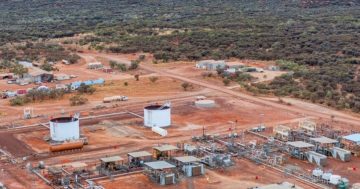Alan Ohnsman (pictured) has found Hydrogen deep underground by natural processes which could be a major new source of untapped carbon-free power–and unlike oil or gas, the supply is virtually unlimited.
 The push to wean the planet off carbon-free fuels and transition to renewable energy has focused mainly on wind and solar power.
The push to wean the planet off carbon-free fuels and transition to renewable energy has focused mainly on wind and solar power.
But mounting scientific evidence suggests there’s an untapped clean energy source deep underground that could provide vastly more power than we need: hydrogen created by natural geologic processes.
And like the oil industry’s early days in the 19th century, it’s spawning a wave of drilling startups vying to be first to find big deposits.
“View them like oil wildcatters right now,” Doug Wicks, director of the U.S. Energy Department’s Advanced Research Projects Agency-Energy, told Forbes, equating hydrogen hunters to traditional drillers scouting for petroleum in new fields.
Globally, he says the amount of geologic hydrogen may be “astronomical” based on how common the geologic conditions needed to generate it appear to be: Iron-rich pockets of water near tectonic rifts, located worldwide.
Potentially, “it’s 150 trillion metric tons,” Wicks said. “One billion tons would power the United States for a full year.”
Big energy companies like Shell, BP and Chevron are joining a consortium created by the U.S. Geological Survey and Colorado School of Mines to study geologic hydrogen, but a handful of ambitious startups are already on the hunt.
HyTerra and Natural Hydrogen Energy are preparing to drill for it in Nebraska and Kansas, and Gold Hydrogen is searching for it in Australia.
French researchers believe it exists in old coal mines in the country’s Alsace-Lorraine region and are seeking it there.
In Africa, Montreal-based Hydroma is already tapping a hydrogen well discovered years ago in Mali and is looking for more. (On the hydrogen color spectrum, the geologic variety is also known as gold or white; hydrogen made with renewable power is green. The form produced from natural gas is grey.)
Tracking down potential hydrogen sites requires skills similar to those used in the oil and gas industry, and getting to it thousands of feet underground uses the same drilling rigs. But unlike oil and gas deposits, which are both dirty and finite, natural hydrogen is generated continuously.
There are different theories as to how it’s generated, but the main view is that it’s a byproduct of a continuous chemical reaction of water mixing with iron in an oxidation state. It’s an intermediate stage, “not quite full rust, not metal,” according to Wicks.
“Imagine the potential of an underground factory fueled by nature, that generates a replenishing supply of clean, dispatchable energy,” said Luke Velterop, COO of Subiaco, Australia-based HyTerra.
He believes that geologic hydrogen “resolves the intermittency of renewable power and provides the security and stability needed to displace fossil fuels.”
The universe’s most abundant element has been a compelling but elusive form of clean energy for decades. It’s not quite as unobtainable as nuclear fusion, but it still faces big challenges.
It’s currently vital for oil refining, making fertilizer, chemicals and food processing and steel production. Run it through a fuel cell and it creates electricity to power cars and trucks with only water vapor as a byproduct.
It can be made cheaply and easily from natural gas but that generates carbon pollution. Making it from water and renewable power solves that problem but creates another: green hydrogen requires more energy to generate than it provides when used. The appeal of geologic hydrogen is that it solves both of these problems.
Hydrogen-Eating Microbes
It’s been commonly thought that because hydrogen is the lightest element on the periodic table, it existed mainly in combination with other elements and not on its own. But reports of naturally occurring hydrogen go back decades. I
n 1984, hydrogen enthusiast Roger Billings believed he’d found a field of natural hydrogen in Kansas. According to a contemporary UPI report, his company, Missouri-based Billings Energy, wanted to tap its energy potential, which was estimated at the equivalent to 65 million barrels of oil. Billings didn’t reply to an email seeking details on why it failed.
More recently, the existence of natural hydrogen has been a hot topic. At Montana State University, scientists have been monitoring hydrogen belched out of Yellowstone National Park’s boiling cauldrons.
Sciencemagazine published a detailed piece in February 2023 on the discovery of a hydrogen well in Mali in 2015, which Hydroma is tapping.
So why has it taken so long to start hunting for natural hydrogen? Aside from not knowing to look for it, geologic hydrogen’s presence is hidden by microbes in the ground that consume it, said Geoff Ellis, a petroleum geochemist with the USGS’s Energy Resources Program.
“It’s not that surprising that it’s been overlooked because it’s a colourless, odourless gas and these microbes eat it really efficiently in the subsurface as it’s leaking out of the ground,” Ellis told Forbes .
“There could be really large accumulations in the ground. We just have to figure out where to find them and we can just drill down there and have this great clean energy source.”
But he cautions that while there’s a vast potential volume of geologic hydrogen globally, much of it may be too hard to get to.
He estimates globally there could be at least 10 million megatons of hydrogen in the ground, vastly more than the 100 megatons the world now uses for industrial processes. New applications of the element for things like aviation fuel and stationary power generation will raise global demand to at least 500 megatons over the next two decades.
“So if just 2% or 3% of the 10 million megatons out there can be tapped, that would supply all of the world’s demand of 500 million tons per year for hundreds of years,” he said.
And it’s not just the potential for cheap, clean hydrogen. Importantly, the underground conditions creating hydrogen may also generate highly valuable helium, an industrial gas that’s grown more expensive as traditional supplies tighten, Ellis said.
HyTerra, which has raised $4 million to fund initial drilling efforts and is seeking a few million dollars more, partnered with Natural Hydrogen Energy on a well project in Geneva, Nebraska.
This month, the startup said it also has drilling rights to search for hydrogen deposits along Kansas’s Nemaha Ridge. Both sites are located along the 1200-mile Midcontinent Rift System, a tectonic fissure through the middle of North America.
Building A Hydrogen Market
Figuring out where large volumes of geologic hydrogen exist and finding ways to safely extract the gas are challenges yet to be solved.
The DOE’s Wicks also wants to create a federal grant program to help company and university researchers develop methods to stimulate the natural underground process that generates hydrogen, potentially using chemical or electrical methods to substantially boost the amount already being created.
That could prove to be critical to commercializing geologic hydrogen as it would help companies coax more out of the ground.
“We would be the first governmental program, foreign or domestic, to acknowledge this possibility,” Wicks said.
Confirming that large commercial quantities of natural hydrogen can be pulled from underground sources could take years, but that’s not a dealbreaker. It’s still early days for the use of hydrogen as a fuel beyond its current industrial niche; the market hasn’t formed yet, according to the USGS’s Ellis.
“If I drill the well out in my backyard today and found a bunch of hydrogen, I wouldn’t be able to sell it to anybody, probably,” he said. That’s part of the reason why HyTerra and Natural Hydrogen Energy are working together on a drilling project in Nebraska.
“They chose that site because there’s a fertilizer plant just down the road,” he said.
“They contacted them and said, ‘Would you buy hydrogen from us?’ And the plant said, ‘Sure, we would.’ So they had a market close by.”
If smaller startups show some success, big oil companies, with the ability to invest billions of dollars into geologic hydrogen, may join the race, Ellis said.
“They’re not looking at drilling wells yet. They’re taking a wait-and-see kind of attitude.”
* On Forbes staff, Alan Ohnsman covers advanced transportation and climate-oriented technology and co-writes the Current Climate newsletter.











